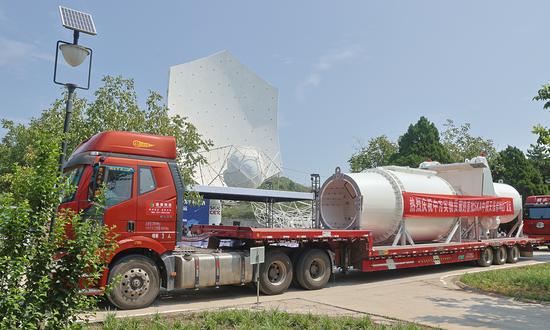China delivers antennas for building the world's largest radio telescope array
As China's contribution to the world's largest intergovernmental international radio telescope project Square Kilometer Array Observatory (SKAO), the first batch of the China-built middle-frequency antenna dishes of the Square Kilometer Array (SKA) radio telescope set off for South Africa on Wednesday.
The antenna dishes to be installed in Karoo, the remote desert region in South Africa, are expected to help detect signals from the most distant parts of the universe, marking a significant step of China in participating in the international mega-science project.
The first four antenna dishes, officially abbreviated as SKA-Mid, have passed the factory acceptance test in quality in Shijiazhuang, North China's Hebei Province, and will be transported by heavy-lift trucks to a port in North China's Tianjin Municipality, where they will be shipped to South Africa.
The SKA is an ambitious scientific endeavor which is jointly funded, built and run by more than 10 countries including China, the UK, Australia and South Africa, with more than 100 organizations from 18 different countries participating in the development of the telescope. It will feature much higher sensitivity and survey speeds than any other radio instrument array developed so far.
The SKA is a collection of various types of antennas, called an array, and the middle-frequency dish is the core facility of the middle-frequency array in the SKA radio telescope.
China is responsible for the research and development of the SKA-Mid dishes as well as the mass production for the instruments. The first batch of the 64 SKA-Mid dishes will be expected to be installed by the end of 2026, marking China's contribution in human's exploration into the universe.
Another major section of the SKA project, the low-frequency antennas, or SKA-Low, will be located in the remote Murchison area in Western Australia.
Hundreds of thousands of SKA antennas will be built in multiple sites including South Africa, and its eight African partner countries, including Botswana, Ghana and Kenya, as well as in Australia.
When the project is completed, it is spread over long distances with up to one square kilometer in total collecting surface area, the equivalent of 140 soccer fields.
The SKA radio telescope carries the mission of helping humanity understand the mysteries of the universe and life, and is dedicated to exploring fundamental questions such as exploring the origin and evolution of the universe and galaxies, discovering more galaxies, searching for new cradles of life, and seeking extraterrestrial life.

